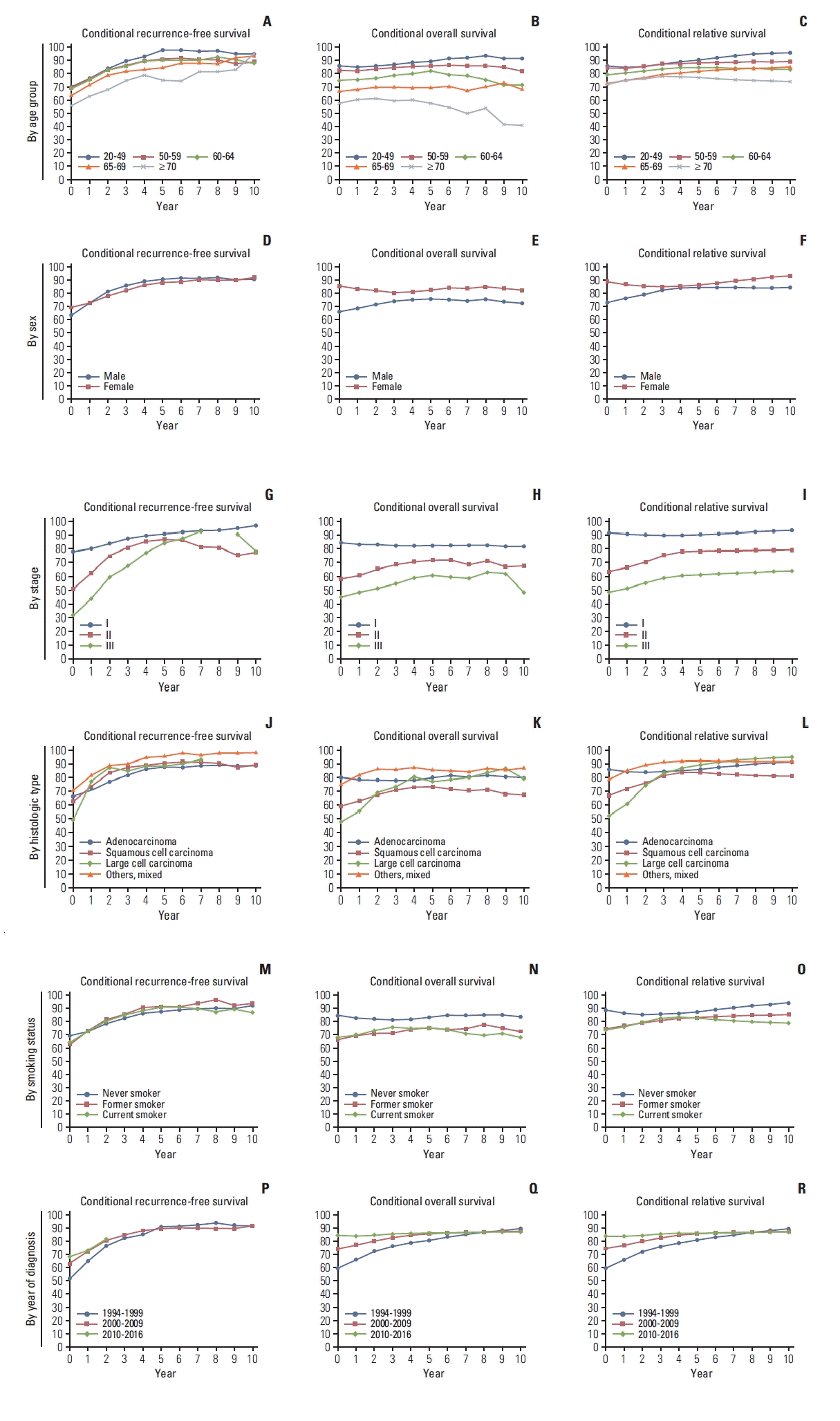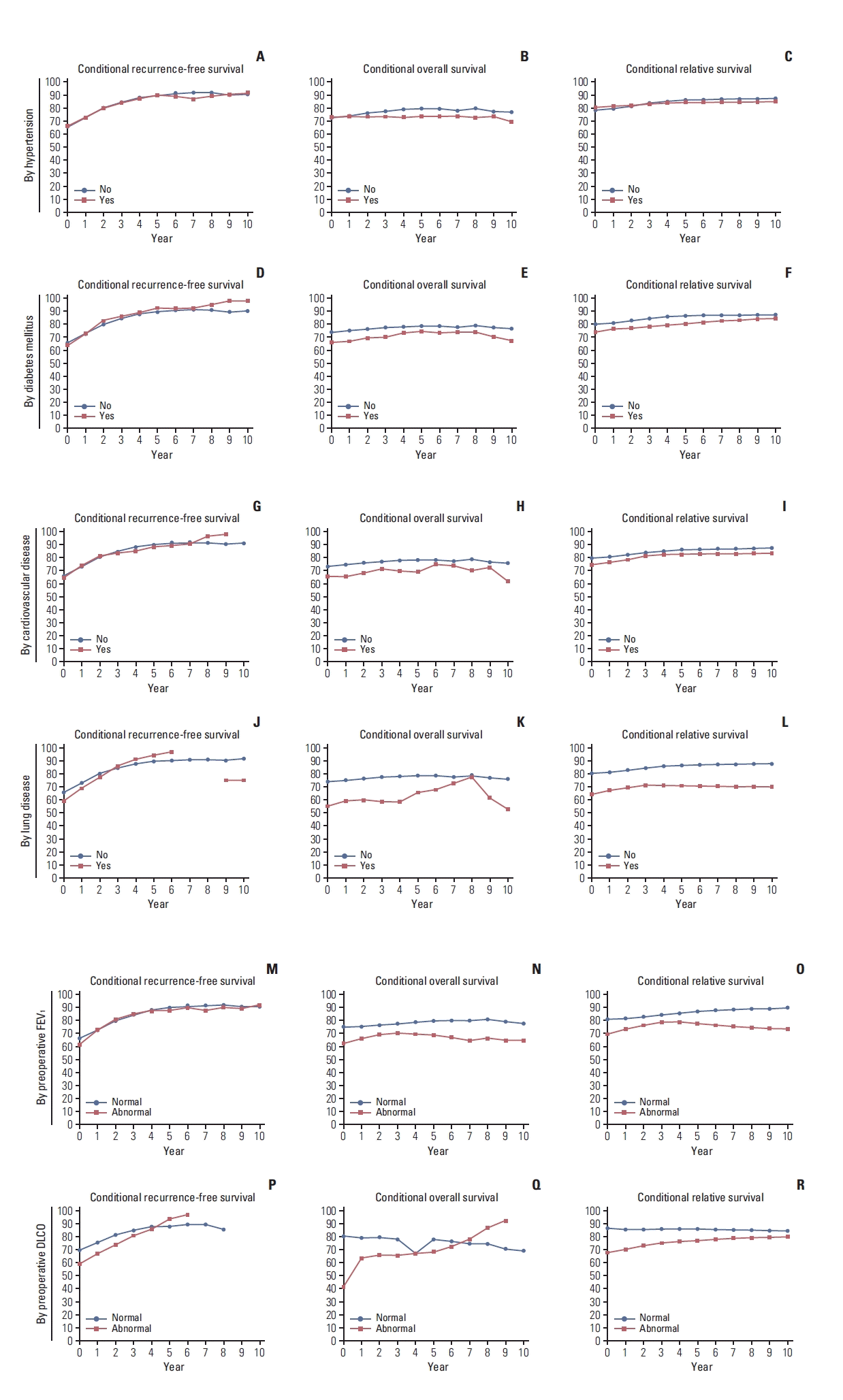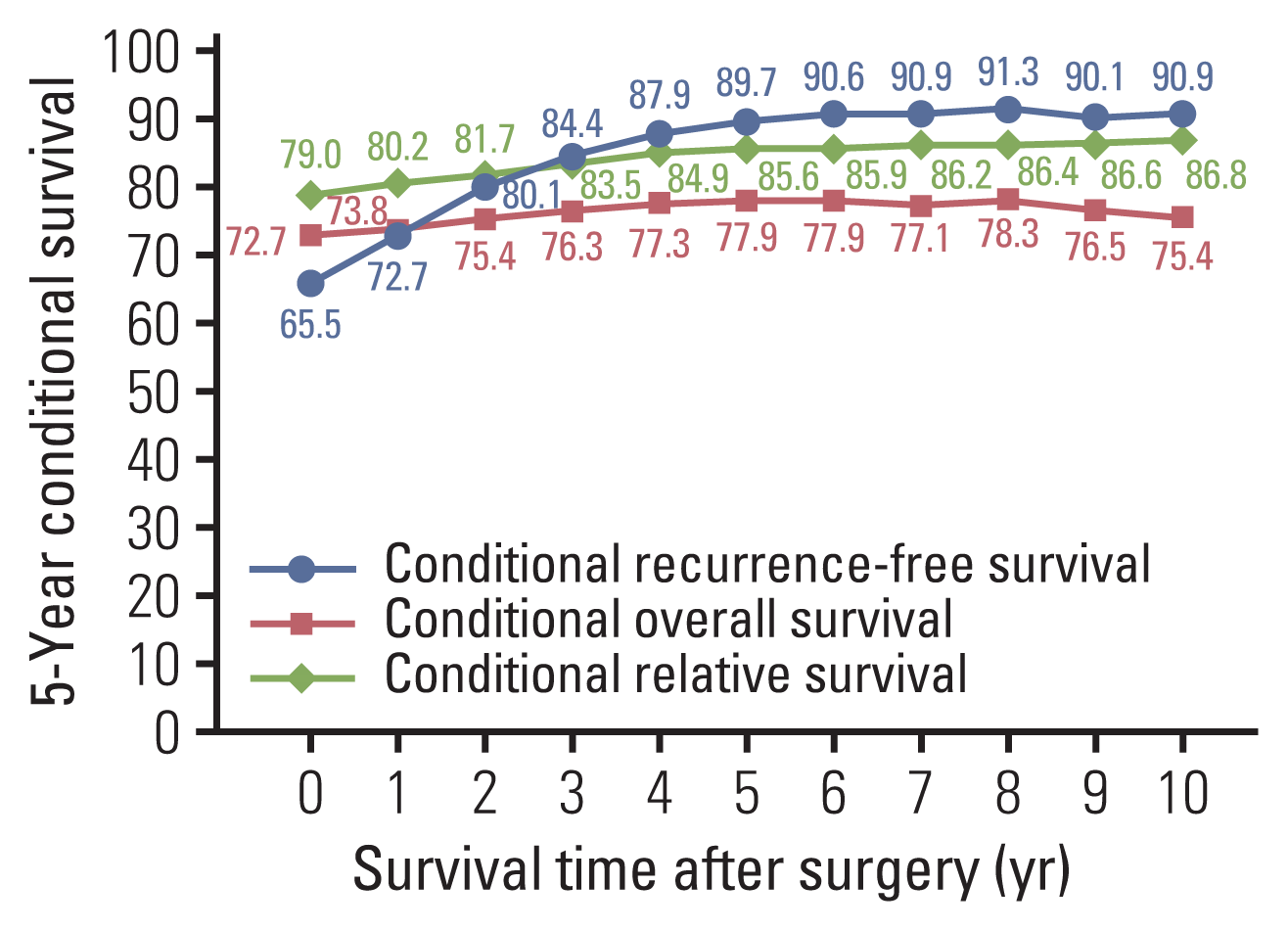Introduction
Materials and Methods
1. Study population
2. Data collection and follow-up
3. Statistical analysis
Results
1. Baseline characteristics
Table 1
Cardiovascular disease includes a history of ischemic heart disease, heart failure, and cerebrovascular disease. Lung disease includes a history of chronic pulmonary obstructive disease, asthma, and diffuse interstitial lung disease. Numbers of each category might not sum up to the total number due to missing information: n=7,288 for smoking, n=8,592 for FEV1, n=6,173 for DLCO. DLCO, single-breath carbon monoxide diffusion capacity; FEV1, forced expiratory volume in 1 second; ICD-O-3, International Classification of Diseases for Oncology, 3rd edition; SD, standard deviation.
2. Traditional RFS, OS, and RS from baseline
Table 2
| Recurrence-free survival (%)a) | Overall survival (%) | Overall relative survival (%) | ||||
|---|---|---|---|---|---|---|
|
|
|
|
||||
| 5 Years (95% CI) | 10 Years (95% CI) | 5 Years (95% CI) | 10 Years (95% CI) | 5 Years (95% CI) | 10 Years (95% CI) | |
| Total | 65.5 (64.3–66.8) | 58.8 (57.0–60.5) | 72.7 (71.6–73.7) | 56.7 (55.2–58.1) | 79 (78.8–79.1) | 67.8 (67.6–68.0) |
|
|
||||||
| Age (yr) | ||||||
|
|
||||||
| 20–49 | 70.1 (66.5–73.5) | 68.6 (64.8–72.1) | 85.7 (83.0–88.0) | 76.5 (72.8–79.9) | 88.3 (88.2–88.4) | 81.4 (81.2–81.5) |
|
|
||||||
| 50–59 | 69.3 (67.0–71.5) | 63.2 (60.1–66.2) | 82.4 (80.6–84.0) | 70.6 (67.9–73.1) | 84.4 (84.3–84.4) | 75.4 (75.4–75.5) |
|
|
||||||
| 60–64 | 68.5 (65.7–71.2) | 61.9 (58.0–65.6) | 75.1 (72.7–77.3) | 61.5 (58.2–64.7) | 80.3 (80.2–80.3) | 69.5 (69.4–69.6) |
|
|
||||||
| 65–69 | 63.4 (60.5–66.2) | 53.6 (49.0–57.9) | 66.6 (64.0–69.0) | 46.1 (42.7–49.5) | 74.3 (74.2–74.3) | 61.1 (60.9–61.2) |
|
|
||||||
| ≥ 70 | 56.0 (52.8–59.0) | 42.0 (35.1–48.7) | 57.9 (55.5–60.4) | 33.2 (29.8–36.7) | 71.2 (71.1–71.3) | 56.9 (56.8–57.1) |
|
|
||||||
| Sex | ||||||
|
|
||||||
| Male | 63.3 (61.8–64.9) | 57.3 (55.2–59.3) | 66.1 (64.8–67.4) | 50.1 (48.3–51.8) | 78.3 (78.2–78.5) | 66.9 (66.7–67.1) |
|
|
||||||
| Female | 69.3 (67.1–71.5) | 61.1 (57.7–64.3) | 85.6 (84.1–87.0) | 70.6 (68.0–73.1) | 80.2 (80.0–80.4) | 69.6 (69.3–69.9) |
|
|
||||||
| Histology (ICD-O-3) | ||||||
|
|
||||||
| Adenocarcinoma | 66.4 (64.8–68.0) | 58.2 (55.6–60.7) | 80.0 (78.7–81.2) | 63.7 (61.6–65.7) | 79.7 (79.5–79.9) | 68.9 (68.7–69.1) |
|
|
||||||
| Squamous cell carcinoma | 62.6 (60.2–64.9) | 56.8 (53.7–59.7) | 59.1 (57.0–61.1) | 43.3 (40.9–45.7) | 76.9 (76.7–77.2) | 64.9 (64.6–65.3) |
|
|
||||||
| Large cell carcinoma | 49.3 (41.7–56.5) | 43.6 (35.0–51.9) | 47.8 (40.6–54.6) | 36.8 (29.6–44.0) | 77.9 (77.1–78.7) | 66.3 (65.1–67.4) |
|
|
||||||
| Others/Mixed | 70.5 (66.1–74.5) | 67.3 (62.4–71.7) | 74.4 (70.5–78.0) | 63.5 (58.7–68.0) | 80.9 (80.3–81.5) | 70.7 (69.8–71.5) |
|
|
||||||
| Stage at diagnosis | ||||||
|
|
||||||
| I | 78.2 (76.7–79.6) | 71.2 (69.0–73.4) | 84.5 (83.4–85.6) | 69.6 (67.8–71.4) | 79.3 (79.1–79.4) | 68.3 (68.0–68.5) |
|
|
||||||
| II | 50.6 (47.8–53.2) | 43.9 (40.4–47.4) | 58.0 (55.6–60.4) | 41.7 (38.8–44.5) | 78.3 (78.0–78.5) | 66.8 (66.4–67.2) |
|
|
||||||
| III | 31.3 (28.0–34.5) | 26.5 (23.0–30.1) | 45.0 (41.8–47.9) | 27.4 (24.1–30.8) | 78.7 (78.3–79.1) | 67.5 (67.0–68.0) |
|
|
||||||
| Year of diagnosis | ||||||
|
|
||||||
| 1994–1999 | 51.5 (46.7–56.1) | 46.7 (41.8–51.5) | 53.5 (49.0–57.8) | 39.03 (34.7–43.3) | 80.0 (79.5–80.5) | 69.3 (68.6–70.1) |
|
|
||||||
| 2000–2009 | 63.3 (61.4–65.2) | 56.6 (54.3–58.3) | 68.1 (66.4–69.8) | 53.7 (51.8–55.6) | 79.1 (78.9–79.3) | 68.0 (67.7–68.4) |
|
|
||||||
| 2010–2016 | 68.5 (66.6–70.3) | 78.0 (76.6–79.3) | 78.8 (78.6–79.0) | 67.6 (67.4–67.8) | ||
|
|
||||||
| Smoking status | ||||||
|
|
||||||
| Never smoker | 69.3 (67.2–71.3) | 60.9 (57.6–63.9) | 84.6 (83.1–86.0) | 70.3 (67.8–72.7) | 88.9 (88.8–88.9) | 77.9 (77.8–80.0) |
|
|
||||||
| Ex-smoker | 62.9 (60.4–65.2) | 57.5 (54.0–60.8) | 66.2 (64.0–68.3) | 49.6 (46.6–52.5) | 74.6 (74.3–75.0) | 62.7 (62.2–63.2) |
|
|
||||||
| Current smoker | 64.2 (61.7–66.7) | 58.5 (55.1–61.8) | 67.8 (65.6–69.9) | 50.8 (47.7–53.7) | 73.7 (73.3–74.0) | 61.5 (61.0–62.0) |
|
|
||||||
| Comorbidities | ||||||
|
|
||||||
| Hypertension | ||||||
|
|
||||||
| No | 65.3 (63.8–66.8) | 58.5 (56.4–60.5) | 72.5 (71.2–73.8) | 57.8 (56.0–59.5) | 78.0 (77.8–78.2) | 67.5 (67.3–67.8) |
|
|
||||||
| Yes | 66.0 (63.7–68.2) | 59.5 (56.2–62.7) | 73.1 (71.2–74.9) | 53.8 (51.0–56.6) | 80.6 (80.5–80.8) | 68.1 (67.9–68.4) |
|
|
||||||
| Diabetes mellitus | ||||||
|
|
||||||
| No | 65.8 (64.4–67.1) | 58.8 (56.9–60.6) | 73.9 (72.7–75.0) | 57.9 (56.3–59.5) | 79.9 (79.8–80.0) | 69.3 (69.1–69.4) |
|
|
||||||
| Yes | 64.1 (60.5–67.4) | 59.2 (54.5–63.6) | 65.7 (62.6–68.6) | 48.9 (44.8–52.9) | 73.9 (73.4–74.3) | 59.8 (59.2–60.5) |
|
|
||||||
| CVD | ||||||
|
|
||||||
| No | 65.6 (64.3–66.9) | 58.9 (57.1–60.7) | 73.4 (72.3–74.4) | 57.6 (56.0–59.1) | 79.5 (79.3–79.6) | 68.5 (68.3–68.7) |
|
|
||||||
| Yes | 64.3 (59.5–68.8) | 56.7 (48.2–64.2) | 65.7 (61.7–69.3) | 45.2 (39.1–51.1) | 74.4 (74.1–74.7) | 61.6 (61.2–62.0) |
|
|
||||||
| Lung disease | ||||||
|
|
||||||
| No | 65.9 (64.6–67.2) | 59.1 (57.2–60.8) | 74.0 (72.9–75.0) | 58.0 (56.5–59.5) | 80.2 (80.1–80.3) | 69.4 (69.2–69.6) |
|
|
||||||
| Yes | 59.4 (54.0–64.4) | 55.9 (49.3–62.0) | 55.1 (50.4–59.5) | 36.1 (30.0–42.2) | 63.7 (62.9–64.5) | 45.8 (44.8–46.9) |
|
|
||||||
| Preoperative pulmonary function | ||||||
|
|
||||||
| FEV1 < 80% of predicted | ||||||
|
|
||||||
| No | 66.2 (64.8–67.6) | 59.6 (57.7–61.5) | 74.9 (73.8–76.1) | 59.5 (57.9–61.1) | 81.1 (80.9–81.2) | 70.6 (70.4–70.8) |
|
|
||||||
| Yes | 61.3 (58.2–64.4) | 53.8 (49.0–58.3) | 62.3 (59.5–64.9) | 80.3 (78.9–81.6) | 69.3 (69.1–69.6) | 54.2 (53.8–54.6) |
|
|
||||||
| DLCO < 80% of predicted | ||||||
|
|
||||||
| No | 69.5 (67.7–71.3) | 60.9 (56.8–64.7) | 80.3 (78.9–81.6) | 62.3 (59.2–65.2) | 86.5 (86.4–86.7) | 74.5 (74.2–74.7) |
|
|
||||||
| Yes | 58.7 (54.2–62.9) | 54.8 (48.5–60.6) | 41.1 (34.1–48.0) | 41.1 (34.1–48.0) | 67.9 (67.3–68.5) | 53.5 (52.7–54.3) |
3. Conditional RFS, OS, and RS
 | Fig. 2Conditional survival estimates in all patients who underwent curative surgery for non-small cell lung cancer stratified by patient characteristics: conditional recurrence-free survival (A, D, G, J, M, P), conditional overall survival (B, E, H, K, N, Q), and conditional relative survival (C, F, I, L, O, R). Events for recurrence-free survival included recurrence only and deaths were censored. |
 | Fig. 3Conditional survival estimates in all patients who underwent curative surgery for non-small cell lung cancer stratified by comorbidities and preoperative lung function: conditional recurrence-free survival (A, D, G, J, M, P), conditional overall survival (B, E, H, K, N, Q), and conditional relative survival (C, F, I, L, O, R). Events for recurrence-free survival included recurrence only and deaths were censored. DLCO, single-breath carbon monoxide diffusion capacity; FEV1, forced expiratory volume in 1 second. |




 PDF
PDF Citation
Citation Print
Print



 XML Download
XML Download